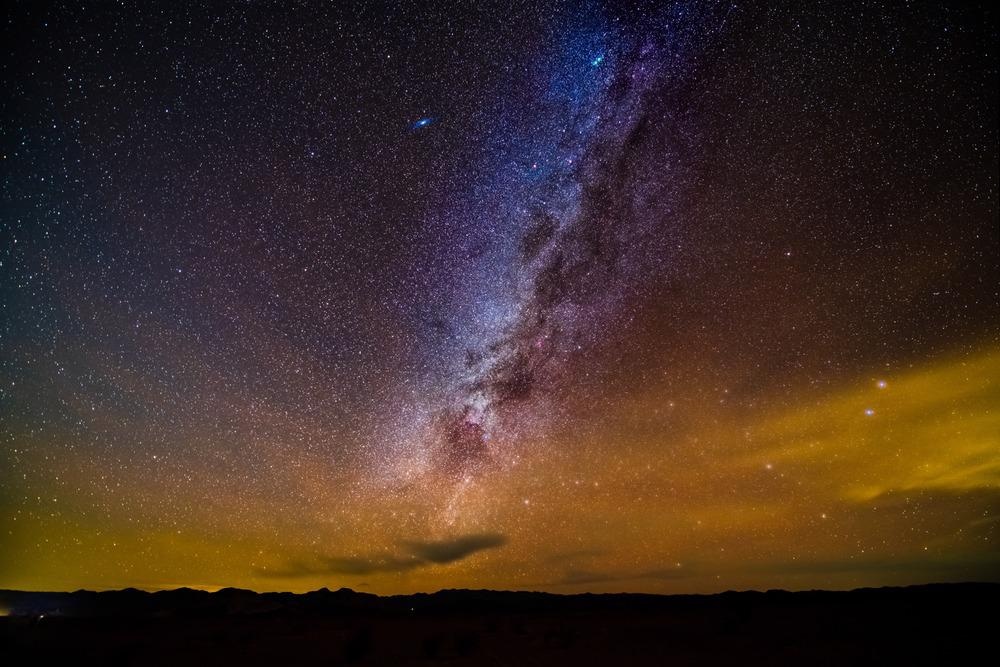Using the MilkyWay@home Volunteer Computer, astronomers have calculated the mass and size of a dwarf galaxy destroyed in a collision billions of years ago.

Image Credit: Behzad Falsafi/Shutterstock.com
Astronomers have for the first time reconstructed the mass and size of a dwarf galaxy that was ripped apart billions of years ago in a collision with the Milky Way.
Because the remains of this galaxy are threaded through the Milky Way in the form of streams of stars — or a stellar tidal stream — this reconstruction could help scientists better understand the results of galactic collisions, and how such events help massive galaxies like the Milky Way grow and evolve.
In addition to this, research like this could also help scientists better map the distribution of dark matter — the mysterious substance that makes up most of the Universe’s matter but does not interact with light or matter — through the Milky Way.
The stellar stream that the team focused on is the Orphan-Chenab Stream, determining that its progenitor dwarf galaxy had a total mass of around 2.0× 10⁷ solar masses, which is 20 million times the mass of the sun. The astronomers estimate that just 1 percent of this mass was made up of stars and other ordinary matter, with the rest composed of dark matter.
This puts this dwarf galaxy at the lower end of the scale of such galaxies and means it was much less massive than the dwarf galaxies that accompany the Milky Way today.
To reach their findings, the team from Rensselaer Polytechnic Institute, including professor of physics, astrophysics, and astronomy Heidi Newberg, used the MilkyWay@home Volunteer Computer system. The system uses volunteered computing resources for a highly accurate three-dimensional model of the Milky Way galaxy using data gathered by the Sloan Digital Sky Survey.
With the aid of the system, the researchers could take the stream of stars and wind back time by billions of years to see what the galaxy looked like before it was cannibalized by the Milky Way. The astronomers’ research is currently published on the website arXiv and is featured in The Astrophysical Journal.
Reconstructing A Cosmic Collision
Billions of years ago, our Milky Way galaxy pulled surrounding dwarf galaxies into itself, growing in size as it did so. These galaxies were distorted and stretched then finally ripped apart by powerful tidal forces.
This had the effect of taking the stars of these galaxies and stretching them into a stellar thread, and then weaving this thread through the Milky Way. These kinds of mergers are fairly common throughout the histories of galaxies. So much so, that researchers estimate that the majority of the stars in the galactic halo of the Milky Way — a spherical cloud of stars, gas, and dust that surrounds our spiral-shaped galaxy — are “immigrant” stars deposited in this way.
Studying these stellar streams and the speed at which stars move through them, and factoring in that they were once in the same location, reveals changes in gravity along their path.
Because it is the gravity of the Milky Way that is responsible for the tidal forces that rip these galaxies apart, it means that the position and velocities of the tidal stream stars carry information that gives a good impression of how the gravitational field is distributed.
MilkyWay@home Nbody Lite
Video Credit: MilkywayAtHomeRPI/Youtube.com
And, because dark matter is responsible for the majority of this gravitational field, its distribution alongside the distribution of visible matter like stars, dust, and gas in the Milky Way should point to the distribution of dark matter.
But tracking a galaxy back billions of years into history to its point of destruction is no mean feat. It requires a great deal of computing power. That is where the MilkyWay@home Volunteer Computer comes into play.
The MilkyWay@home Volunteer Computer is a project jointly operated by Rensselaer Polytechnic Institute’s departments of Computer Science and Physics, Applied Physics and Astronomy.
The project runs on the Berkeley Open Infrastructure for Network Computing (BOINC) platform and makes use of spare computing power from over 38,000 computers run by over 27,000 volunteers.
That is how the system is able to deliver highly accurate three-dimensional models of stellar streams.
If the discovery that this progenitor dwarf galaxy that birthed the Orphan-Chenab stream did indeed have such a relatively small mass, comparable to low-mass ultralight dwarf galaxies, then it could change how scientists model merger events, how small systems form, and how larger galaxies grow.
Newberg has lofty goals for the MilkyWay@home system. She hopes that one day it could be used to measure many dwarf galaxies cannibalized by our galaxy to understand their movement through the Milky Way.
This goal is made difficult due to the changes a galaxy undergoes over the millions of years it takes to rip apart dwarf galaxies and integrate immigrant star streams.
You can add computer power to the MilkyWay@home Computer by volunteering at https://milkyway.cs.rpi.edu/milkyway/signup.php.
References and Further Reading
Mendelsohn. E. J., Newberg. H. J., Shelton. S., et al, [2022], “Estimate of the Mass and Radial Profile of the Orphan-Chenab Stream’s Dwarf Galaxy Progenitor Using MilkyWay@home,” The Astrophysical Journal, https://arxiv.org/abs/2201.03637
MilkyWay@home, Rensselaer. https://milkyway.cs.rpi.edu/milkyway/
Disclaimer: The views expressed here are those of the author expressed in their private capacity and do not necessarily represent the views of AZoM.com Limited T/A AZoNetwork the owner and operator of this website. This disclaimer forms part of the Terms and conditions of use of this website.